Synthesis and Characterization of a Novel Self-Generated Proppant Fracturing Fluid System
Abstract
1. Introduction
- (1)
- During proppant transport, the density of the proppant is much higher than that of the carrying fluid, which makes the proppants settle at the bottom of the fractures and causes an accumulation at the entrance of the fractures [3]. To achieve the goal of suspending the proppants in the carrying fluid, the viscosity of the fluid is usually raised by adding thickening agents. Although this solves the settlement of the proppants, other problems arise [4]. For instance, polymer gels may be left over as residues from the formation process which causes damage [5], or there may be some potential risks in the construction process with the pump pressure and the friction in the pipe being very high due to the use of high-viscosity liquids [6].
- (2)
- In a complex fracture network, the solids may not effectively turn the corner at the junction of the intersecting fractures, which limits the transported distance in the branch fractures and is even likely to bridge off at these intersections leaving only the main planar fracture propped [7].
- (3)
- The proppant placement in conventional fracturing is homogeneous and continuous in the fractures, which makes the flow of oil and gas seep through the intergranular pores of the solid particles, causing the limitations of the reservoir stimulation [8].
- (1)
- No solid injection releases the limitations of the well completion mode on the fracturing. Problems such as sand plugs, high friction inside the tubes, and gel residue damage can be solved. In addition, the high viscosity of the fracturing fluid is no longer required.
- (2)
- The liquids can effectively turn the corner at the junction of the intersecting fractures in the complex fracture network. The limitations of solid transportation can be solved in the branch fractures, which makes both the main planar fractures and branch fractures prop.
- (3)
- The proppant placement controlled by two-phase flow patterns is discontinuous and heterogeneous due to the two kinds of liquids flowing separately in the fractures, which greatly increases the fracture conductivity.
2. Study on the PCL
2.1. Design Principles of the PCL
- (1)
- Sensitive stimuli-responsive
- (2)
- Long-term stability
- (3)
- Phase-change behavior and properties of cured products are controlled
- (4)
- Chemical inertness
- (5)
- Easy to inject
- (6)
- Immiscible
2.2. Component Screening of PCL
- (1)
- Unsaturated polyester
- (2)
- Phenolic resin
- (3)
- Urea-formaldehyde resins
- (4)
- Epoxy resin
2.3. Synthesis of the PCL
2.4. Screening and Synthesis of Curing Agent (CA)
2.5. Modification of the PCL and Testing of Cured Products
3. Study on the NPCL
3.1. Design Principle of the NPCL
- (1)
- Immiscible
- (2)
- Easy to inject
- (3)
- Chemical inertness
- (4)
- The capacity to control the shape, size, and sorting of the PCL
3.2. Screening of the NPCL
- (1)
- Reduce interface energy
4. The Reaction of Fracturing Fluid System under Reservoir Conditions
4.1. Fracturing Fluid Reaction under the Pressure and Fluid of a Reservoir
4.2. Fracturing Fluid Reaction in Complex Fractures
5. Conclusions
- (1)
- The polymer compounds with a glycidyl ether structure have a close molecular structure, high curing efficiency at high temperatures, low curing shrinkage, and good long-term stability at room temperature. These advantages can just meet the requirements of thermal stimulation response and chemical inertia in the design of the phase-change fracturing fluid. The cured product has a certain strength and hardness, good heat resistance, and chemical stability.
- (2)
- By introducing aromatic groups with a rigid structure to synthesize the reactive diluents, the viscosity of the phase-change liquid is reduced from more than 200 MPa·s to about 80 MPa·s, meeting the injectability requirement. Through the hydroxyl reaction between the PF and phase-change liquid, the flexible segment is introduced to modify the amino formate group and long-chain fat chain in the main chain of the molecule, combined with the rigid structure group introduced in the diluent, and in the curing reaction, the epoxy ring-opening branch in the side chain forms a three-dimensional network structure of the bulk polymer so that the cured product of the phase-change liquid has high strength and hardness, resulting in the long-term stability of the cured product.
- (3)
- The design of a non-phase-change fracturing fluid system is based on the interfacial energy theory. By reducing the interfacial tension between two phases and forming an interfacial film, the phase-change fracturing fluid can keep dispersing and be controlled to be spherical. The optimal formula is water + 1.5% surfactant + 0.01% polymer + 0.5% solid particles.
- (4)
- Through the phase-change experiment of the simulated liquid system under complex formation conditions, it is proved that ① the phase-change behavior and the results of the fracturing fluid system are not affected by complex formation conditions and ② the adaptability of the fracturing fluid in complex fractures is good, which not only reflects the advantage of good liquid fluidity, but also makes it easy to turn at the intersection of joints in the fractures, and the dispersion system composed of a two-phase liquid enables the phase-change solid particles to fill the whole fracture.
Author Contributions
Funding
Conflicts of Interest
References
- Tong, S.; Gao, D. Basic research progress and development suggestions on hydraulic fracturing. Oil Drill. Prod. Technol. 2019, 41, 101–115. [Google Scholar]
- Chen, Y. Experimental Study on a New Type of Self-Propping Fracturing Technology; Southwest Petroleum University: Chengdu, China, 2017. [Google Scholar]
- Zhao, L.; Chen, Y.; Du, J.; Liu, P.; Li, N.; Luo, Z.; Zhang, C.; Huang, F. Experimental Study on a New Type of Self-Propping Fracturing Technology. Energy 2019, 183, 249–261. [Google Scholar] [CrossRef]
- Chang, F.F.; Berger, P.D.; Lee, C.H. In-Situ Formation of Proppant and Highly Permeable Blocks for Hydraulic Fracturing. In Proceedings of the Society of Petroleum Engineers SPE Hydraulic Fracturing Technology Conference, The Woodlands, TX, USA, 3 March 2015. [Google Scholar]
- Faroughi, S.A.; Pruvot, J.; Mcandrew, J. The rheological behavior of energized fluids and foams with application to hydraulic fracturing: Review. J. Pet. Sci. Eng. 2017, 163, 243–263. [Google Scholar] [CrossRef]
- Fernandes, C.; Faroughi, S.A.; Ribeiro, R.; Isabel, A.; McKinley, G.H. Finite volume simulations of particle-laden viscoelastic fluid flows: Application to hydraulic fracture processes. Eng. Comput. 2022, 159, 217–234. [Google Scholar] [CrossRef]
- Sahai, R.; Miskimins, J.L. Laboratory Results of Proppant Transport in Complex Fracture Systems. In Proceedings of the Society of Petroleum Engineers SPE Hydraulic Fracturing Technology Conference, The Woodlands, TX, USA, 4 February 2014. [Google Scholar]
- Weijers, L.; Griffin, L.G.; Sugiyama, H.; Shimamoto, T.; Takada, S.; Chong, K.K.; Wright, C.A.; Terracina, J.M. The First Successful Fracture Treatment Campaign Conducted in Japan: Stimulation Challenges in a Deep, Naturally Fractured Volcanic Rock. In Proceedings of the SPE Annual Technical Conference and Exhibition, San Antonio, TX, USA, 29 September–2 October 2002. [Google Scholar]
- Luo, J.; Zhu, Y.; Guo, Q.; Tan, L.; Zhuang, Y.; Liu, M.; Zhang, C.; Zhu, M.; Xiang, W. Chemical stimulation on the hydraulic properties of artificially fractured granite for enhanced geothermal system. Energy 2018, 142, 754–764. [Google Scholar] [CrossRef]
- Smeal, T.W.; Brownell, G.L. Unsaturated Polyesters. U.S. Patent US5500171 A, 19 March 1996. [Google Scholar]
- Ishida, H.; Rodriguez, Y.C. Catalyzing the curing reaction of a new benzoxazine-based phenolic resin. J. Appl. Polym. Sci. 2010, 58, 1751–1760. [Google Scholar] [CrossRef]
- Kosonen, H.; Valkama, S.; Nykänen, A.; Toivanen, M.; ten Brinke, G.; Ruokolainen, J.; Ikkala, O. Functional Porous Structures Based on the Pyrolysis of Cured Templates of Block Copolymer and Phenolic Resin. Adv. Mater. 2010, 18, 201–205. [Google Scholar] [CrossRef]
- Josifovic, A.; Roberts, J.J.; Corney, J.; Davies, B.; Shipton, Z.K. Reducing the environmental impact of hydraulic fracturing through design optimisation of positive displacement pumps. Energy 2016, 115, 1216–1233. [Google Scholar] [CrossRef]
- Ren, H.; Sun, J.Z.; Wu, B.; Zhou, Q.Y. Synthesis and characterization of a novel epoxy resin containing naphthyl/dicyclopentadiene moieties and its cured polymer. Polymer 2006, 47, 8309–8316. [Google Scholar] [CrossRef]
- Rimdusit, S.; Ishida, H. Development of new class of electronic packaging materials based on ternary systems of benzoxazine, epoxy, and phenolic resins. Polymer 2000, 41, 7941–7949. [Google Scholar] [CrossRef]
- Varley, R.J.; Hodgkin, J.H.; Simon, G.P. Toughening of a trifunctional epoxy system-Part VI. Structure property relationships of the thermoplastic toughened system. Polymer 2001, 42, 3847–3858. [Google Scholar] [CrossRef]
- Wu, C.S. Epoxy resins possessing flame retardant elements from silicon incorporated epoxy compounds cured with phosphorus or nitrogen containing curing agents. Polymer 2002, 43, 4277–4284. [Google Scholar] [CrossRef]
- Nakamura, A.; Inoue, Y. Electrostatic manipulation of enantio-differentiating photo-cyclodimerization of 2-anthracenecarboxylate within γ-cyclodextrin cavity through chemical modification. Inverted product distribution and enhanced enantioselectivity. J. Am. Chem. Soc. 2005, 127, 5338–5339. [Google Scholar] [CrossRef]
- Pan, G.; Du, Z.; Zhang, C.; Li, C.; Yang, X.; Li, H. Synthesis, characterization, and properties of novel novolac epoxy resin containing naphthalene moiety. Polymer 2007, 13, 3686–3693. [Google Scholar] [CrossRef]
- Liu, N.; Li, L.; Wang, L.; Zheng, S. Organic-inorganic poly-benzoxazine copolymers with double decker silsesquioxanes in the main chains: Synthesis and thermally activated ring-opening polymerization behavior. Polymer 2017, 109, 254–265. [Google Scholar] [CrossRef]
- Aditi, S.; Niranjan, K. Renewable resource based thermostable tough hyperbranched epoxy thermosets as sustainable materials. Polym. Degrad. Stab. 2017, 135, 8–17. [Google Scholar]
- Chen, S.; Guo, L.; Du, D.; Rui, J.; Qiu, T.; Ye, J.; Li, X. Waterborne POSS-silane-urethane hybrid polymer and the fluorinated films. Polymer 2016, 103, 27–35. [Google Scholar] [CrossRef]
- Raneesh, K.; Jyotis, P.; Kuruvilla, J. Mechanical, thermal, and viscoelastic response of novel in situ CTBN/POSS/epoxy hybrid composite system. Polym. Compos. 2016, 37, 2109–2120. [Google Scholar]
- Rapheepraew, S.; Vuthichai, E. Synthesis of poly (siloxane/ double-decker silses quioxane) via dehy drocarbonative condensation reaction and its functionalization. Polymer 2016, 86, 113–119. [Google Scholar]
- Chen, L.; Zhao, P.; Xie, H.; Yu, W. Thermal properties of epoxy resin based thermal interfacial materials by filling Ag nanoparticle-decorated graphene nanosheets. Compos. Sci. Technol. 2016, 125, 17–21. [Google Scholar] [CrossRef]
- Liu, Z.; Yuan, L.; Liang, G.; Gu, A. Tough epoxy/cyanate ester resins with improved thermal stability, lower dielectric constant and loss based on unique hyperbranched polysiloxane liquid crystalline. Polym. Adv. Technol. 2015, 26, 1608–1618. [Google Scholar] [CrossRef]
- Xu, J.; Zhang, W.; Jiang, Q.; Mu, J.; Jiang, Z. Synthesis and properties of poly (aryl ether sulfone) incorporating cage and linear organ-osiloxane in the backbones. Polymer 2015, 62, 77–85. [Google Scholar] [CrossRef]
- Vahedi, V.; Pasbakhsh, P.; Chai, S.-P. Toward high performance epoxy/halloysite nanocomposites: New insights based on rheological, curing, and impact properties. Mater. Des. 2015, 68, 42–53. [Google Scholar] [CrossRef]
- Jerzy, J.C.; Elżbieta, L. Modification of epoxy resins with functional silanes, poly-siloxanes, silses-quioxanes, silica and silicates. Prog. Polym. Sci. 2015, 41, 67–121. [Google Scholar]
- Matějka, L.; Kroutilová, I.A.; Lichtenhan, J.D.; Haddad, T.S. Structure ordering and reinforcement in POSS containing hybrids. Eur. Polym. J. 2014, 52, 117–126. [Google Scholar] [CrossRef]
- Zhang, W.; Xu, J.; Li, X.; Song, G.; Mu, J. Preparation, characterization, and properties of poly (aryl ether sulfone) systems with double-decker silses-quioxane in the main chains by reactive blending. J. Polym. Sci. Part A Polym. Chem. 2014, 52, 780–788. [Google Scholar] [CrossRef]
- Ma, S.; Liu, X.; Fan, L.; Jiang, Y.; Cao, L.; Tang, Z.; Zhu, J. Synthesis and Properties of a Bio-Based Epoxy Resin with High Epoxy Value and Low Viscosity. Chem. Sus. Chem. 2014, 7, 555–562. [Google Scholar] [CrossRef]
- Xu, Y.-J.; Chen, L.; Rao, W.-H.; Qi, M.; Guo, D.-M.; Liao, W.; Wang, Y.-Z. Latent curing epoxy system with excellent thermal stability, flame retardance and dielectric property. Chem. Eng. J. 2018, 347, 223–232. [Google Scholar] [CrossRef]
- Yang, S.; Zhang, Q.; Hu, Y.; Ding, G.; Wang, J.; Huo, S.; Zhang, B.; Cheng, J. Synthesis of s-triazine based tri-imidazole derivatives and their application as thermal latent curing agents for epoxy resin. Mater. Lett. 2018, 216, 127–130. [Google Scholar] [CrossRef]
- Fei, X.; Wei, W.; Tang, Y.; Zhu, Y.; Luo, J.; Chen, M.; Liu, X. Simultaneous enhancements in toughness, tensile strength, and thermal properties of epoxy-anhydride thermosets with a carboxyl-terminated hyperbranched polyester. Eur. Polym. J. 2017, 90, 431–441. [Google Scholar] [CrossRef]



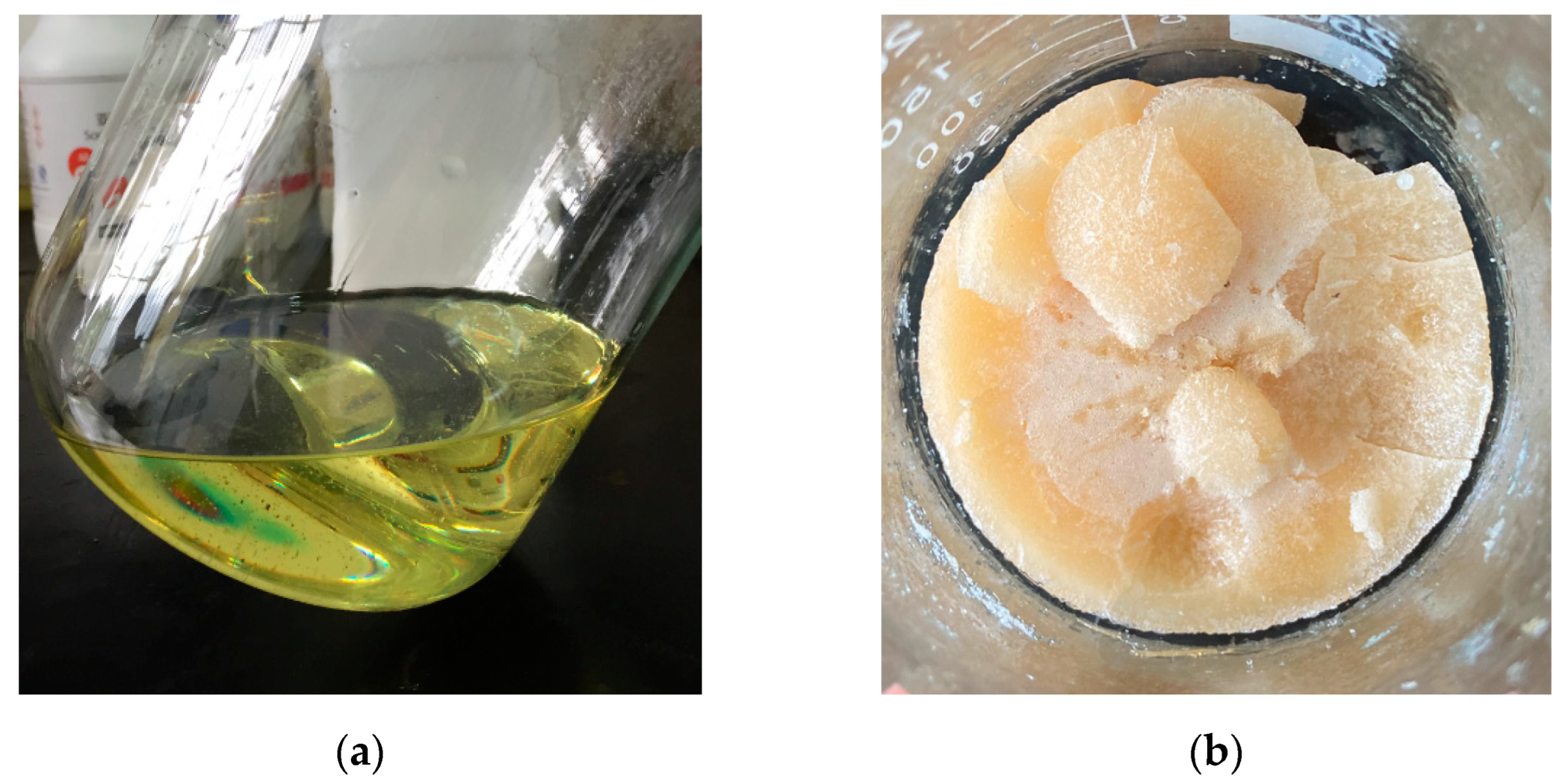
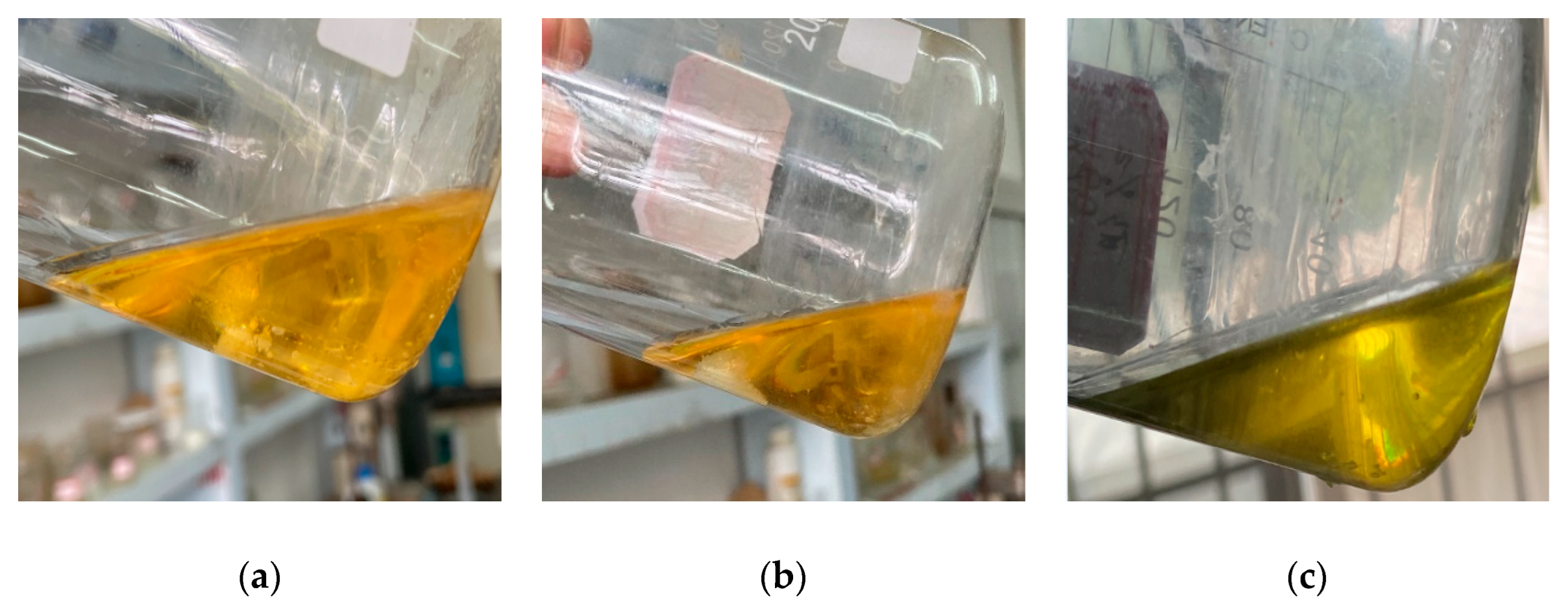
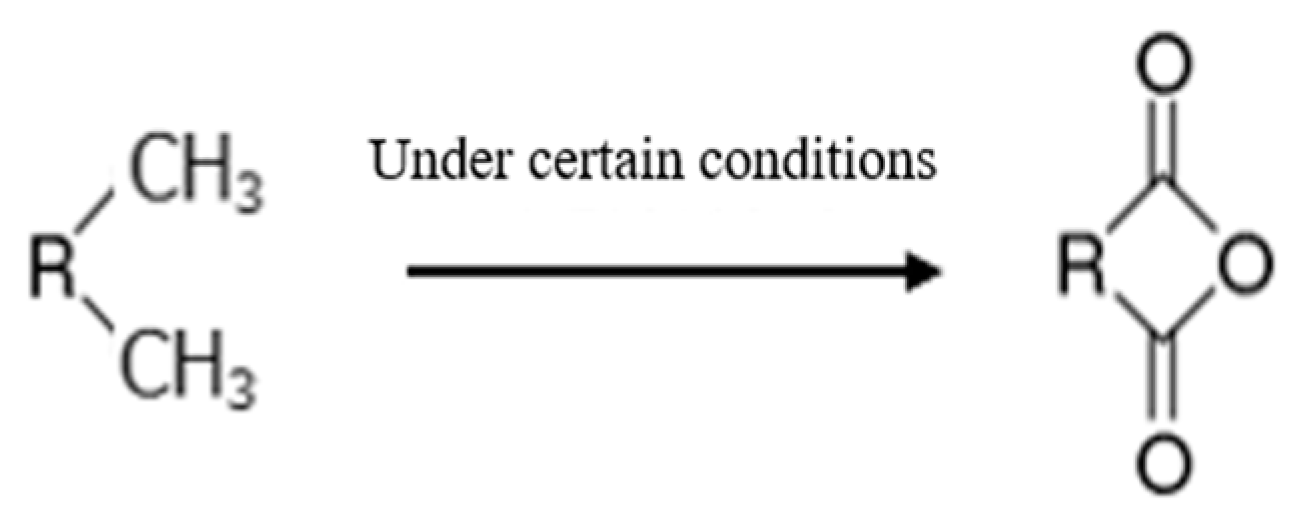
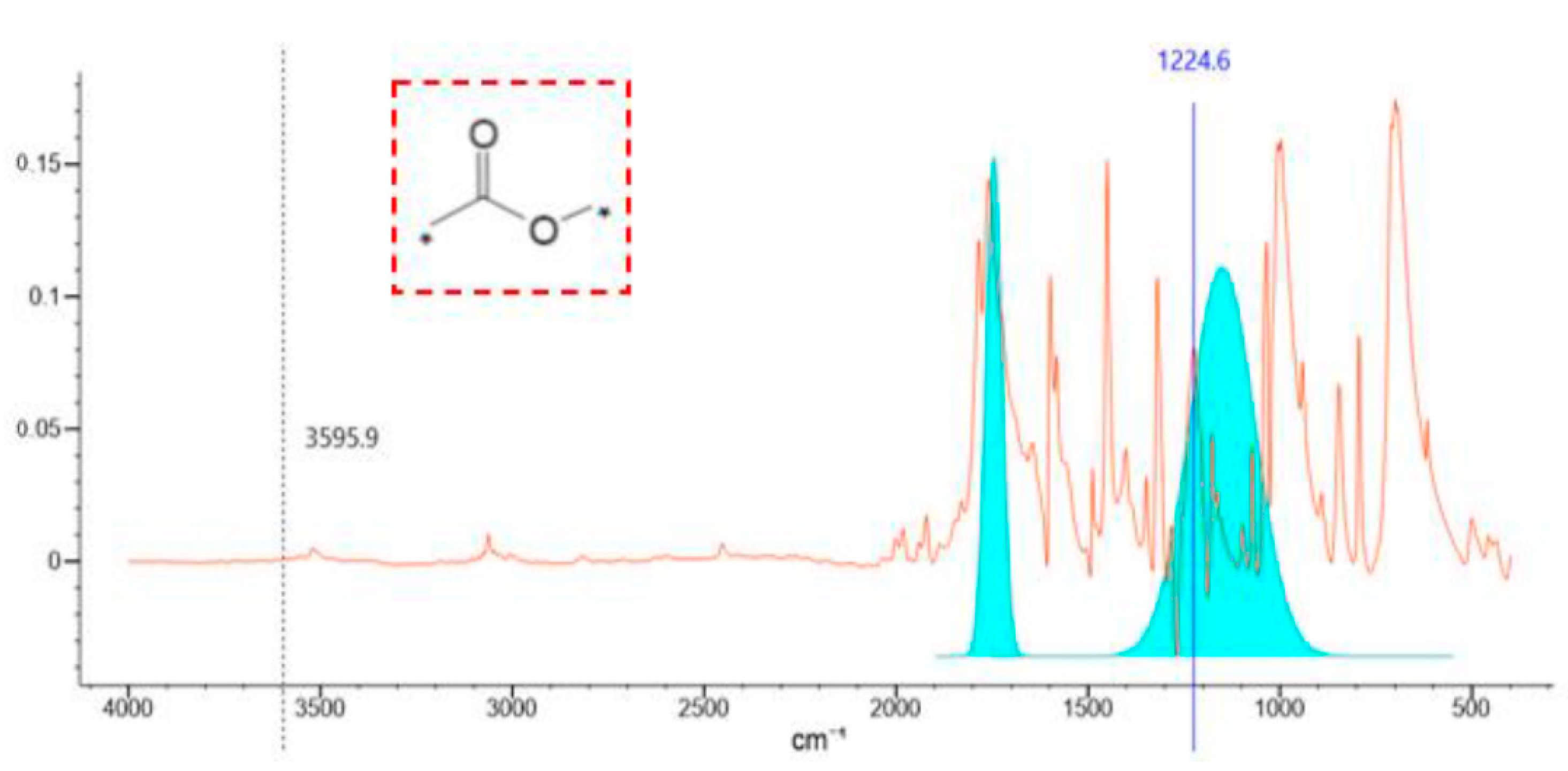

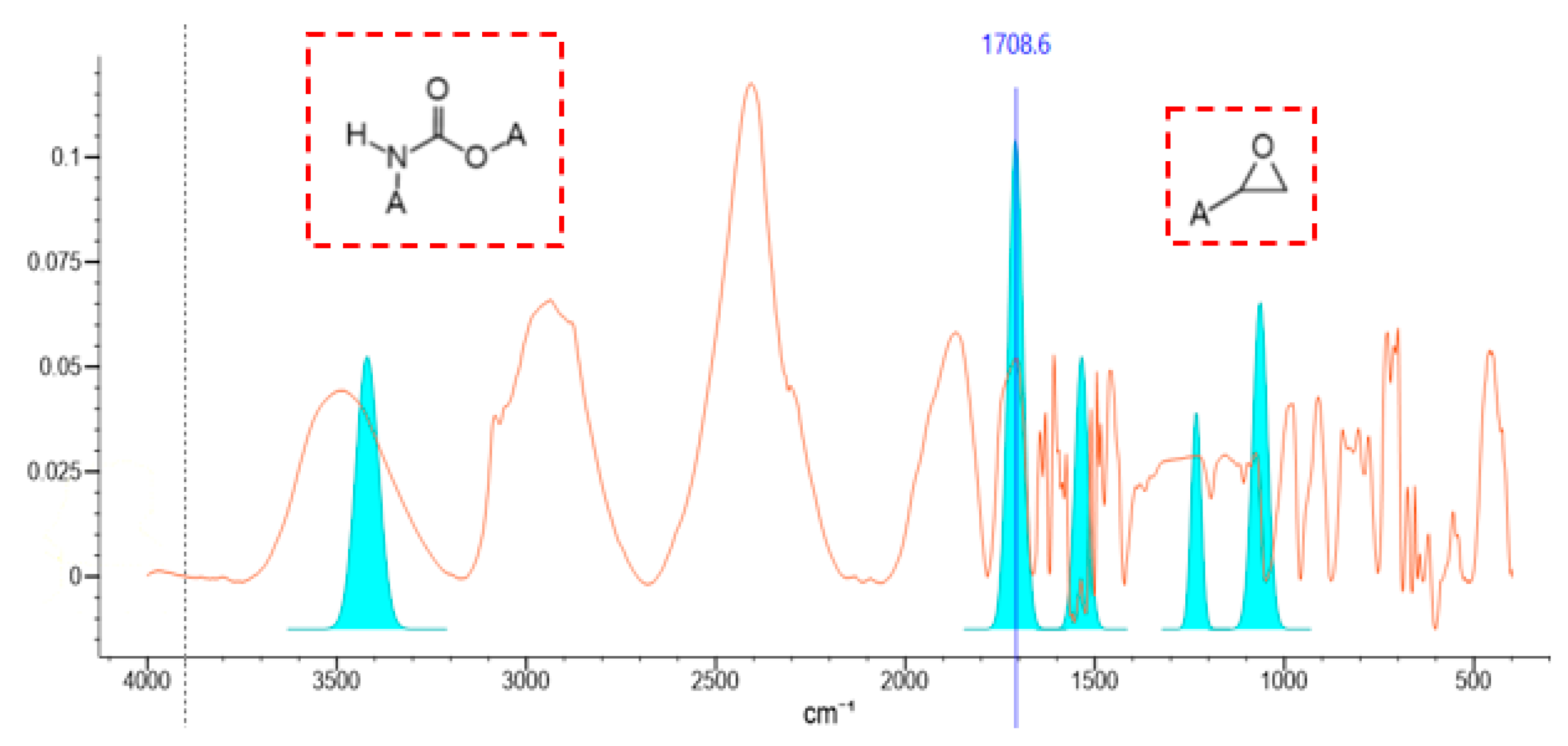


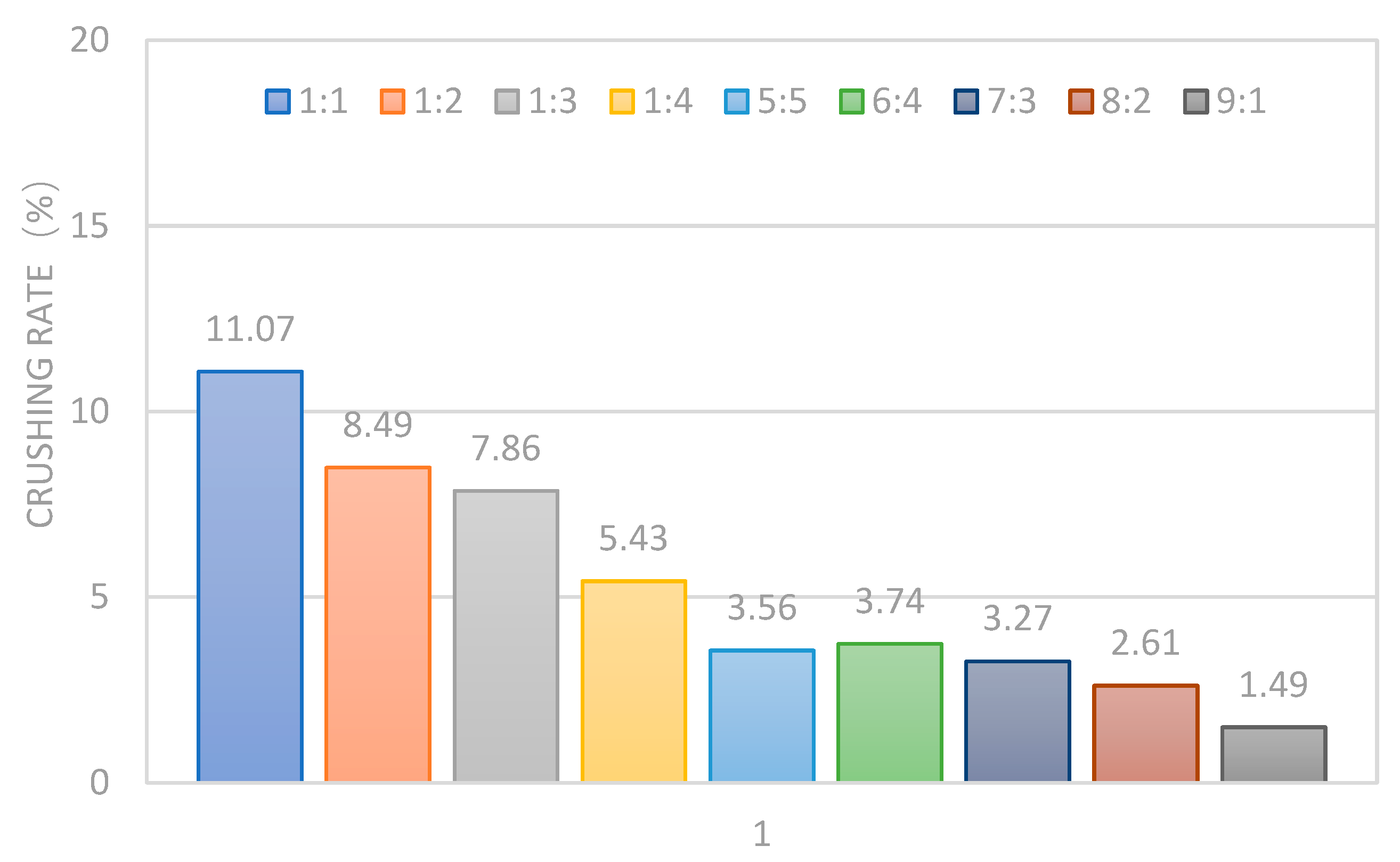

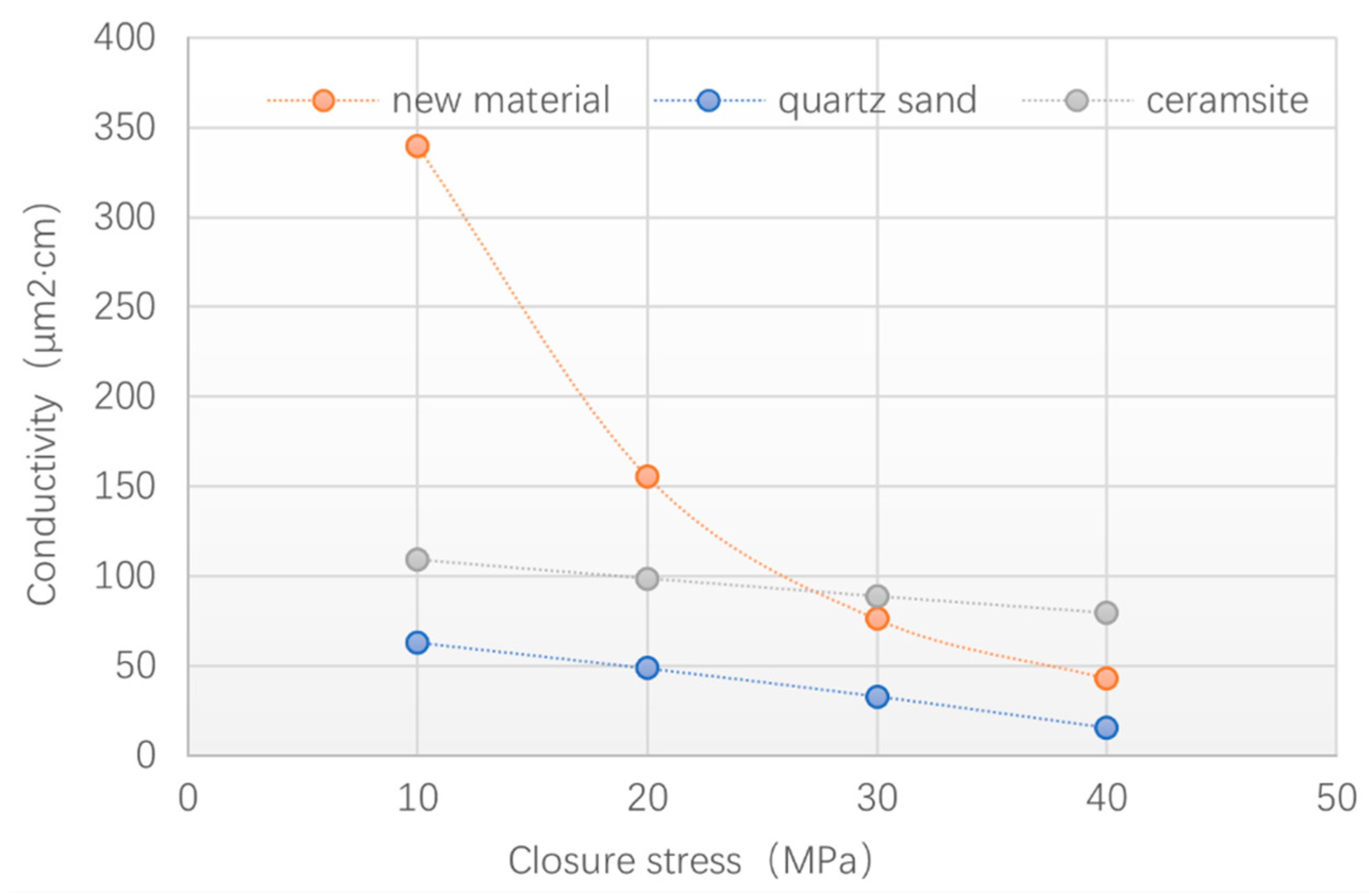
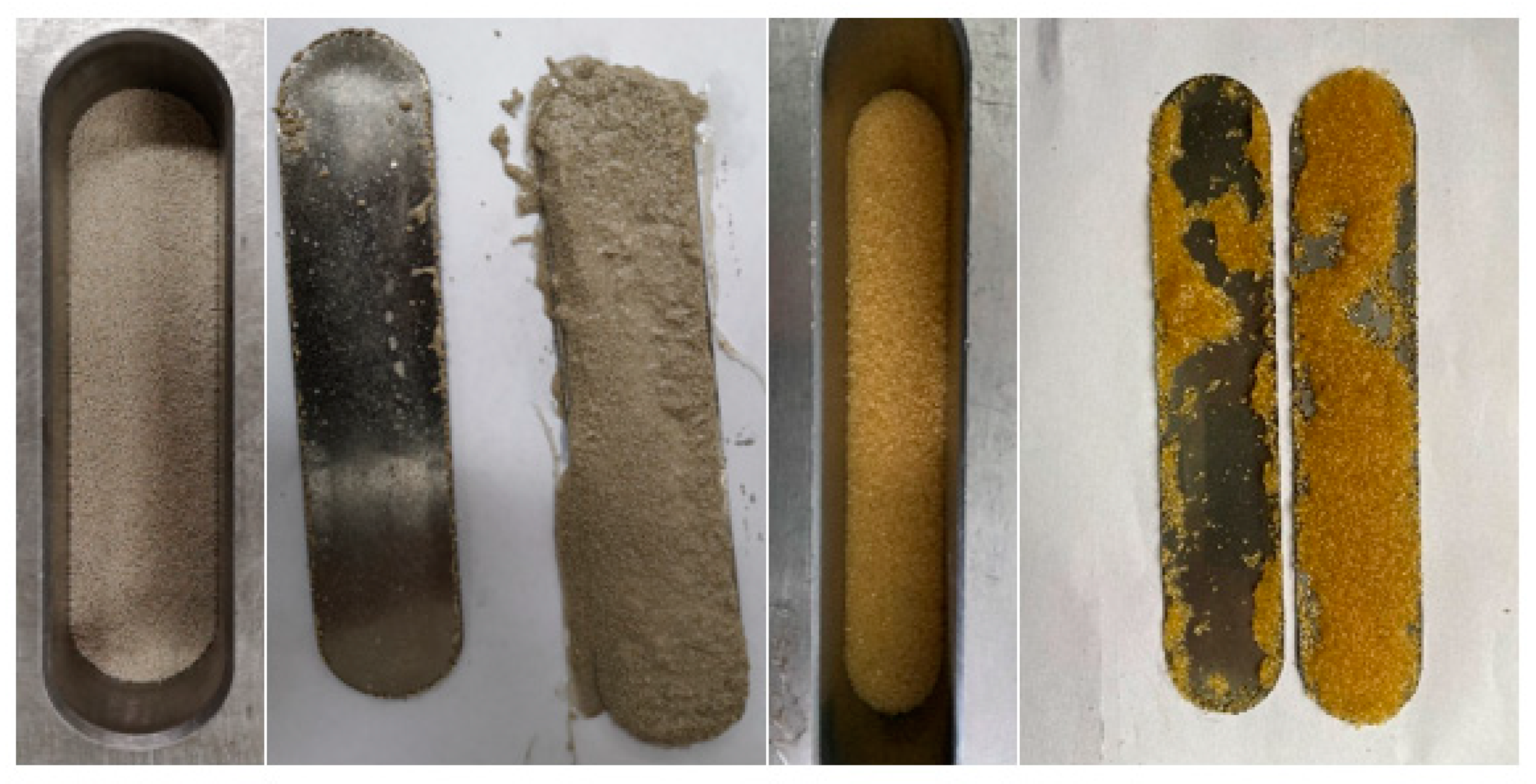
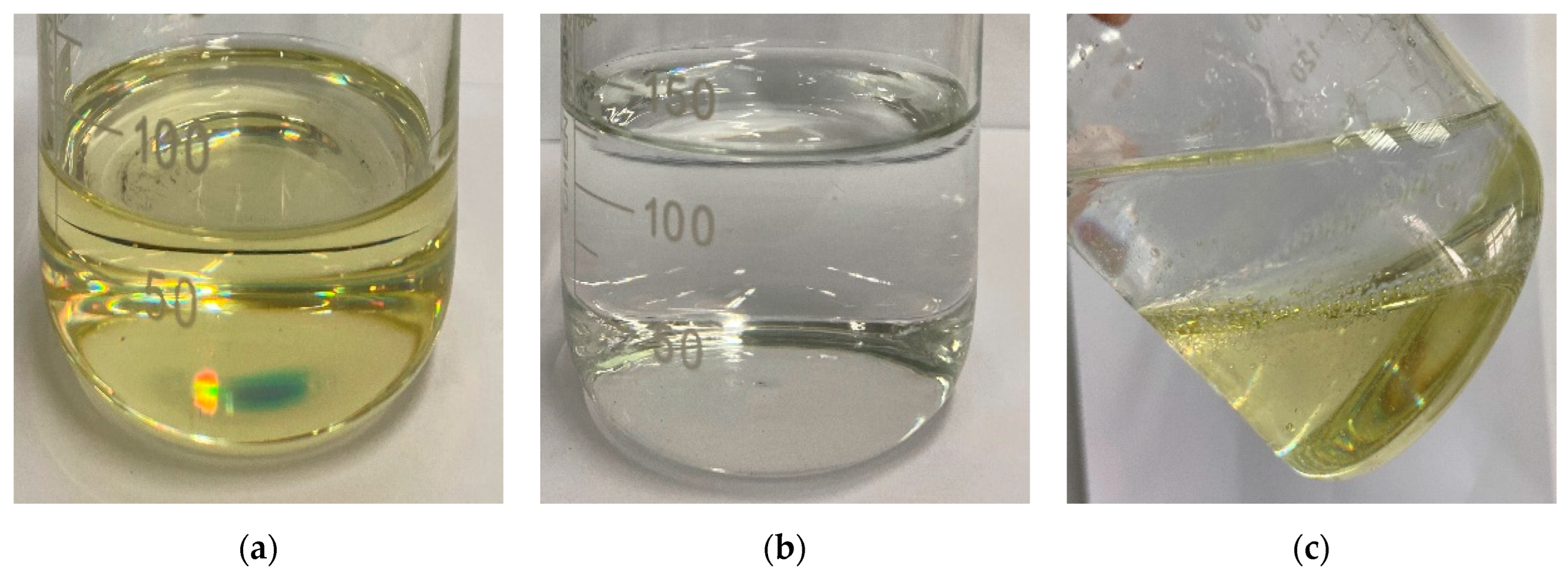



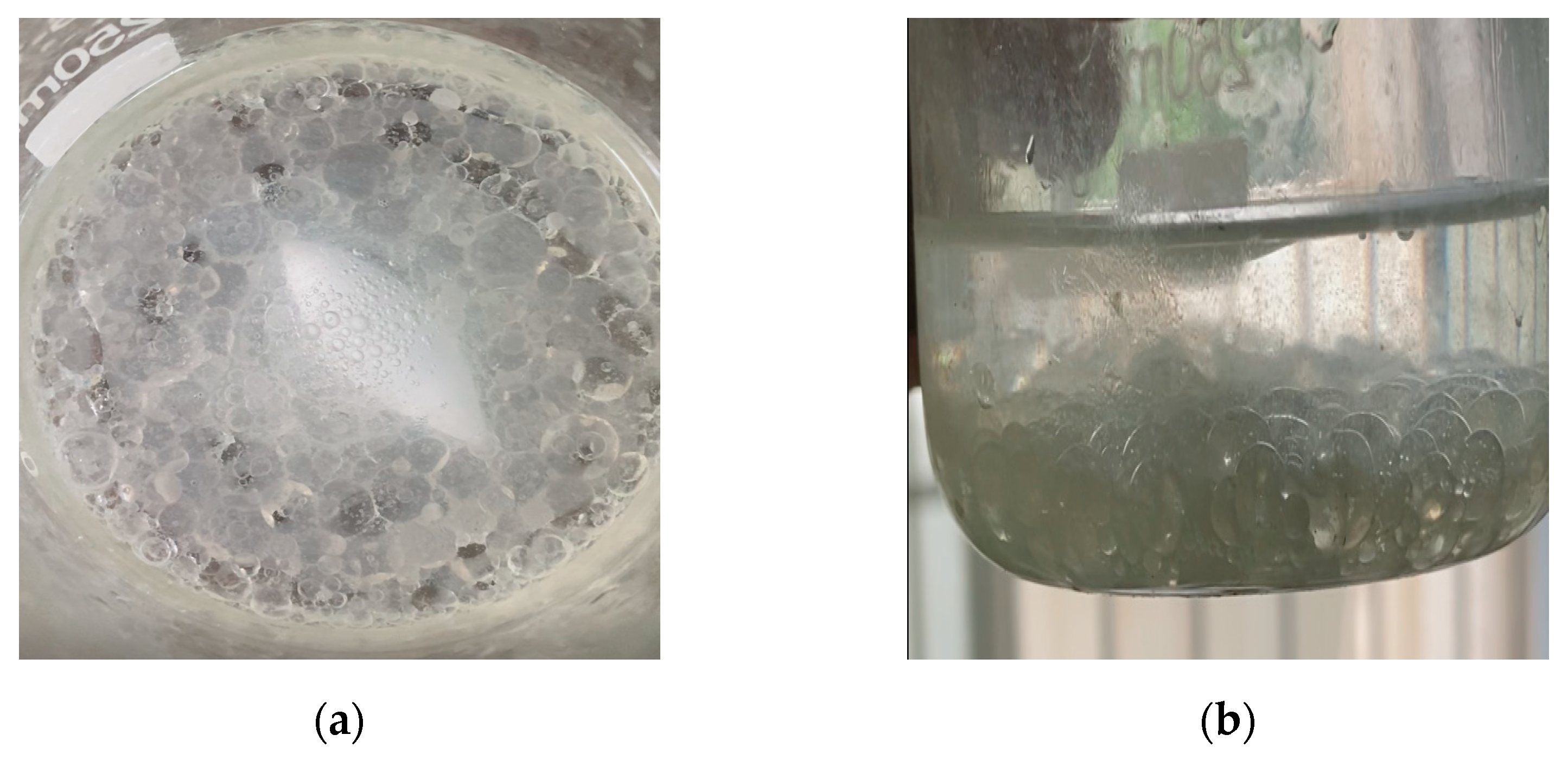


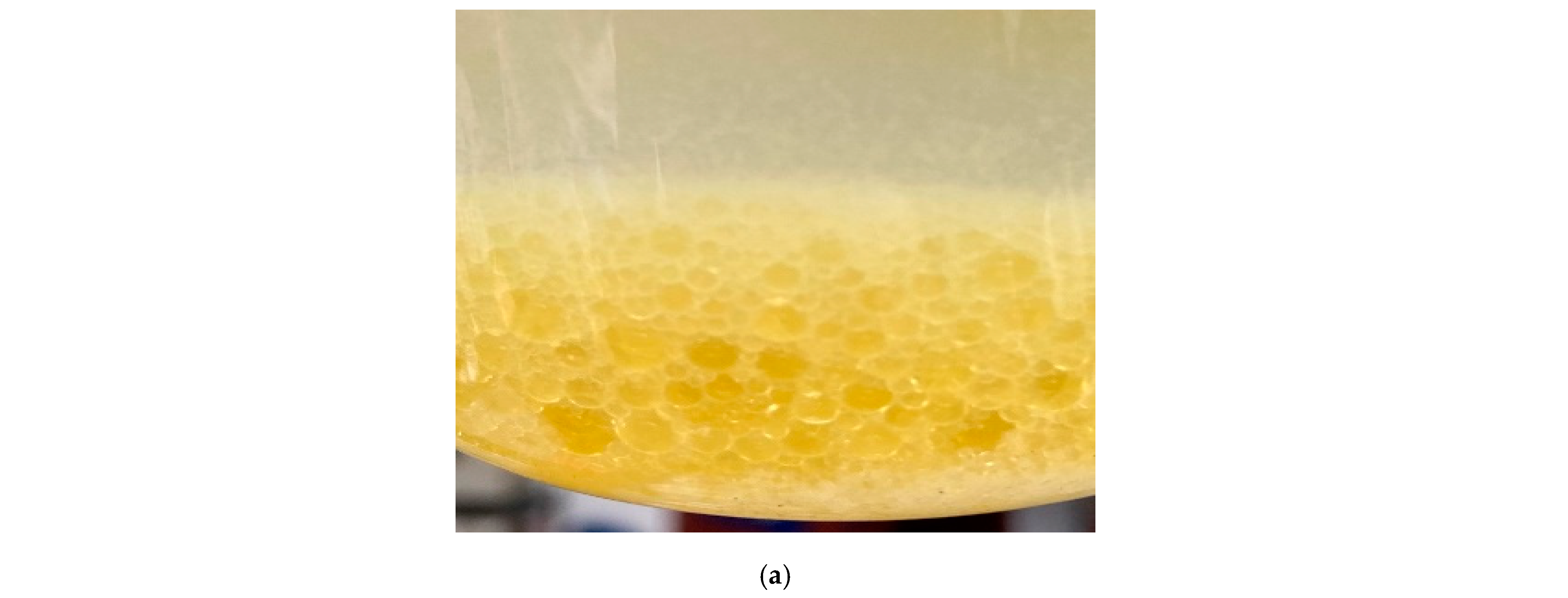


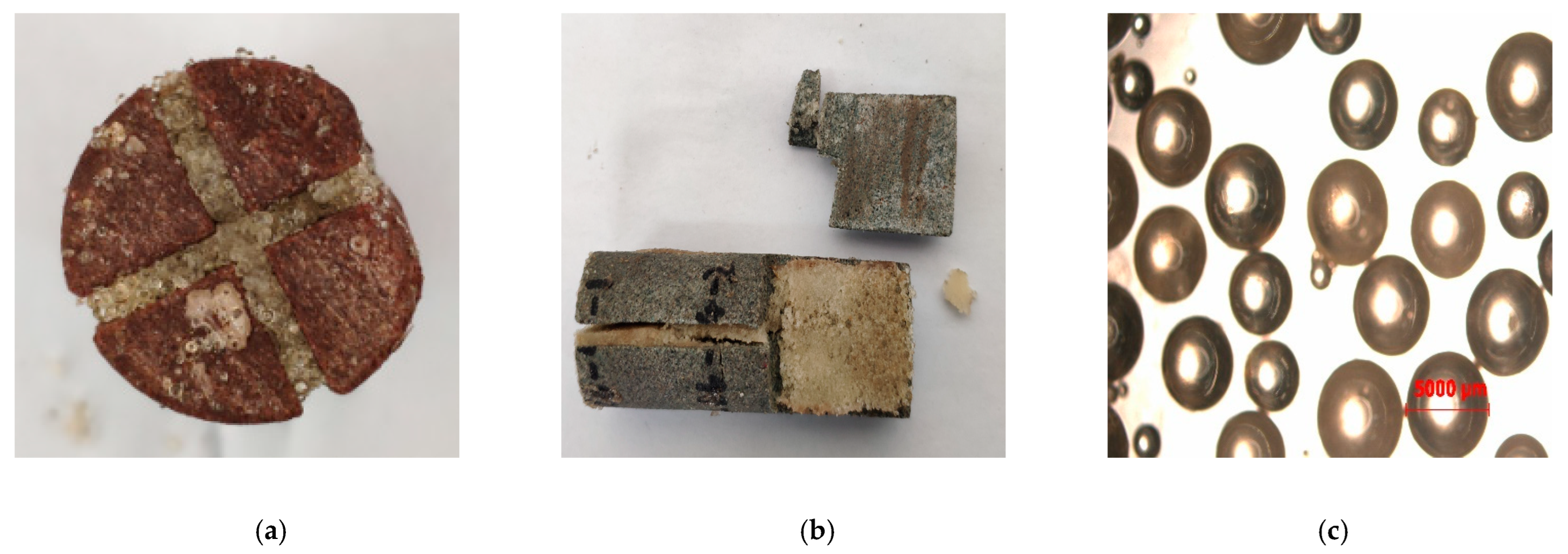
| Types | Structures | Characteristics |
|---|---|---|
| Glycidyl ether |  | Epoxy groups are connected with other groups by ether bonds |
| Glycidyl ester |  | Epoxy groups are linked to other groups through ester bonds |
| Glycidyl amine |  | Epoxy groups are linked to other groups by nitrogen atoms |
| Alicyclic epoxy resin |  | Epoxy groups are connected to alicyclic groups |
| Linear fatty family epoxy resin |  | Polymers with epoxy groups attached to long linear aliphatic chains |
| Imide epoxy resin |  | Epoxy polymer with an imide structure |
| Types | Reaction Mechanism |
|---|---|
| Ring-opening reaction |  |
| Propagation reaction |  |
| Ring-closure reaction |  |
| Types | Manufacturer |
|---|---|
| Epichlorohydrin | Shanghai FangYe Chemical Co., Ltd. |
| Bisphenol-A | Changzhou BoFeng Chemical Co., Ltd. |
| NaOH | Shanghai Aladdin Biochemical Technology Co., Ltd. |
| Distilled water | / |
| Constant pressure-dropping funnel | Zhengzhou Huate Instrument Equipment Co., Ltd. |
| DF-101S magnetic stirring oil bath | Zhengzhou Huate Instrument Equipment Co., Ltd. |
| CA | Reaction Mechanism | Chemical Bond |
|---|---|---|
| Amine |  |  |
| Anhydrides |  |  |
| CA | Advantages | Disadvantages |
|---|---|---|
| Amine | Curing reactions can take place over a wide range of temperatures. | ① The reaction will be accompanied by an intense exothermic effect. ② Poor compatibility with PCL. ③ Volatility. ④ The cured product is fragile. ⑤ Low thermal deformation temperature. |
| Anhydrides | ① Low volatility. ② Great compatibility with PCL. ③ The cured product has better mechanical strength. | Higher temperatures and longer times are required for the curing reaction. |
| Items | Mesh | Closure Stress (MPa) | Crushing Rate (%) |
|---|---|---|---|
| the crushing rate of ceramic proppants | under 6 | 52 | ≤25 |
| 6/20 | 69 | ≤20 | |
| 20/40 | 69 | ≤5 | |
| 40/70 | 86 | ≤10 | |
| 70/140 | 86 | ≤10 | |
| the crushing rates of the main sizes of the new material (RD:PF = 5:5) | under 6 | 52 | 7.66 |
| 6/20 | 69 | 8.42 | |
| 20/40 | 69 | 3.56 |
| CaCl2 (mg/L) | MgCl2·6H2O (mg/L) | NaCl (mg/L) | Total Salinity (mg/L) | Chlorion (mg/L) | |
|---|---|---|---|---|---|
| Low salinity | 5.2 × 102 | 4.315 × 102 | 8.45 × 103 | 9.15 × 103 | 5.75 × 103 |
| High salinity | 2.08 × 103 | 1.726 × 103 | 3.38 × 104 | 3.66 × 104 | 2.3 × 104 |
Publisher’s Note: MDPI stays neutral with regard to jurisdictional claims in published maps and institutional affiliations. |
© 2022 by the authors. Licensee MDPI, Basel, Switzerland. This article is an open access article distributed under the terms and conditions of the Creative Commons Attribution (CC BY) license (https://creativecommons.org/licenses/by/4.0/).
Share and Cite
Chen, Y.; Sang, Y.; Guo, J.; Yang, J.; Chen, W.; Liu, F.; Zeng, J.; Tang, B. Synthesis and Characterization of a Novel Self-Generated Proppant Fracturing Fluid System. Energies 2022, 15, 8737. https://doi.org/10.3390/en15228737
Chen Y, Sang Y, Guo J, Yang J, Chen W, Liu F, Zeng J, Tang B. Synthesis and Characterization of a Novel Self-Generated Proppant Fracturing Fluid System. Energies. 2022; 15(22):8737. https://doi.org/10.3390/en15228737
Chicago/Turabian StyleChen, Yixin, Yu Sang, Jianchun Guo, Jian Yang, Weihua Chen, Fei Liu, Ji Zeng, and Botao Tang. 2022. "Synthesis and Characterization of a Novel Self-Generated Proppant Fracturing Fluid System" Energies 15, no. 22: 8737. https://doi.org/10.3390/en15228737
APA StyleChen, Y., Sang, Y., Guo, J., Yang, J., Chen, W., Liu, F., Zeng, J., & Tang, B. (2022). Synthesis and Characterization of a Novel Self-Generated Proppant Fracturing Fluid System. Energies, 15(22), 8737. https://doi.org/10.3390/en15228737






